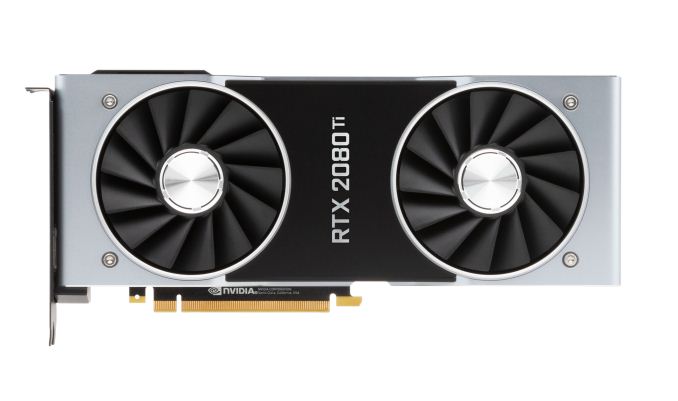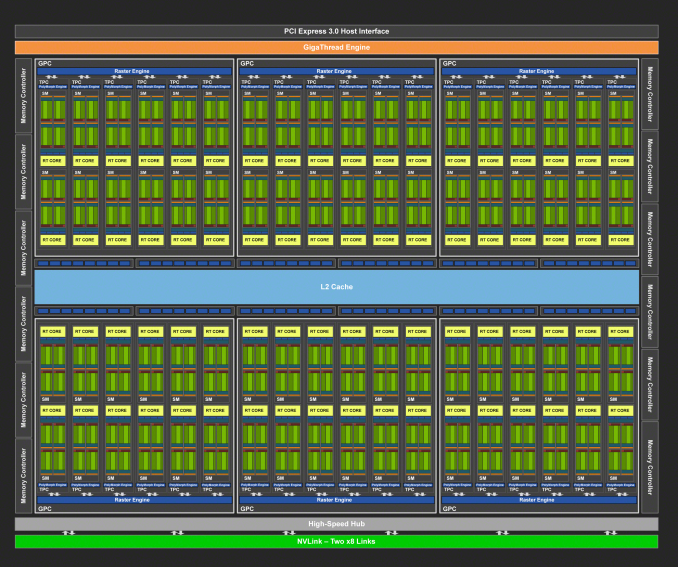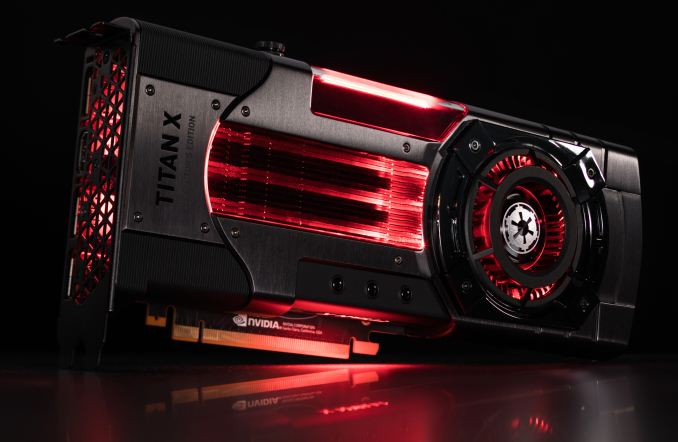The NVIDIA GeForce RTX 2080 Ti & RTX 2080 Founders Edition Review: Foundations For A Ray Traced Future
by Nate Oh on September 19, 2018 5:15 PM EST- Posted in
- GPUs
- Raytrace
- GeForce
- NVIDIA
- DirectX Raytracing
- Turing
- GeForce RTX

While it was roughly 2 years from Maxwell 2 to Pascal, the journey to Turing has felt much longer despite a similar 2 year gap. There’s some truth to the feeling: looking at the past couple years, there’s been basically every other possible development in the GPU space except next-generation gaming video cards, like Intel’s planned return to discrete graphics, NVIDIA’s Volta, and cryptomining-specific cards. Finally, at Gamescom 2018, NVIDIA announced the GeForce RTX 20 series, built on TSMC’s 12nm “FFN” process and powered by the Turing GPU architecture. Launching today with full general availability is just the GeForce RTX 2080, as the GeForce RTX 2080 Ti was delayed a week to the 27th, while the GeForce RTX 2070 is due in October. So up for review today is the GeForce RTX 2080 Ti and GeForce RTX 2080.
But a standard new generation of gaming GPUs this is not. The “GeForce RTX” brand, ousting the long-lived “GeForce GTX” moniker in favor of their announced “RTX technology” for real time ray tracing, aptly underlines NVIDIA’s new vision for the video card future. Like we saw last Friday, Turing and the GeForce RTX 20 series are designed around a set of specialized low-level hardware features and an intertwined ecosystem of supporting software currently in development. The central goal is a long-held dream of computer graphics researchers and engineers alike – real time ray tracing – and NVIDIA is aiming to bring that to gamers with their new cards, and willing to break some traditions on the way.
| NVIDIA GeForce Specification Comparison | ||||||
| RTX 2080 Ti | RTX 2080 | RTX 2070 | GTX 1080 | |||
| CUDA Cores | 4352 | 2944 | 2304 | 2560 | ||
| Core Clock | 1350MHz | 1515MHz | 1410MHz | 1607MHz | ||
| Boost Clock | 1545MHz FE: 1635MHz |
1710MHz FE: 1800MHz |
1620MHz FE: 1710MHz |
1733MHz | ||
| Memory Clock | 14Gbps GDDR6 | 14Gbps GDDR6 | 14Gbps GDDR6 | 10Gbps GDDR5X | ||
| Memory Bus Width | 352-bit | 256-bit | 256-bit | 256-bit | ||
| VRAM | 11GB | 8GB | 8GB | 8GB | ||
| Single Precision Perf. | 13.4 TFLOPs | 10.1 TFLOPs | 7.5 TFLOPs | 8.9 TFLOPs | ||
| Tensor Perf. (INT4) | 430TOPs | 322TOPs | 238TOPs | N/A | ||
| Ray Perf. | 10 GRays/s | 8 GRays/s | 6 GRays/s | N/A | ||
| "RTX-OPS" | 78T | 60T | 45T | N/A | ||
| TDP | 250W FE: 260W |
215W FE: 225W |
175W FE: 185W |
180W | ||
| GPU | TU102 | TU104 | TU106 | GP104 | ||
| Transistor Count | 18.6B | 13.6B | 10.8B | 7.2B | ||
| Architecture | Turing | Turing | Turing | Pascal | ||
| Manufacturing Process | TSMC 12nm "FFN" | TSMC 12nm "FFN" | TSMC 12nm "FFN" | TSMC 16nm | ||
| Launch Date | 09/27/2018 | 09/20/2018 | 10/2018 | 05/27/2016 | ||
| Launch Price | MSRP: $999 Founders $1199 |
MSRP: $699 Founders $799 |
MSRP: $499 Founders $599 |
MSRP: $599 Founders $699 |
||
As we discussed at the announcement, one of the major breaks is that NVIDIA is introducing GeForce RTX as the full upper tier stack with x80 Ti/x80/x70 stack, where it has previously tended towards the x80/x70 products first, and the x80 Ti as a mid-cycle refresh or competitive response. More intriguingly, each GeForce card has their own distinct GPU (TU102, TU104, and TU106), with direct Quadro and now Tesla variants of TU102 and TU104. While we covered the Turing architecture in the preceding article, the takeaway is that each chip is proportionally cut-down, including the specialized RT Cores and Tensor Cores; with clockspeeds roughly the same as Pascal, architectural changes and efficiency enhancements will be largely responsible for performance gains, along with the greater bandwidth of 14Gbps GDDR6.
And as far as we know, Turing technically did not trickle down from a bigger compute chip a la GP100, though at the architectural level it is strikingly similar to Volta/GV100. Die size brings more color to the story, because with TU106 at 454mm2, the smallest of the bunch is frankly humungous for a FinFET die nominally dedicated for a x70 GeForce product, and comparable in size to the 471mm2 GP102 inside the GTX 1080 Ti and Pascal Titans. Even excluding the cost and size of enabled RT Cores and Tensor Cores, a slab of FinFET silicon that large is unlikely to be packaged and priced like the popular $330 GTX 970 and still provide the margins NVIDIA is pursuing.
These observations are not so much to be pedantic, but more so to sketch out GeForce Turing’s positioning in relation to Pascal. Having separate GPUs for each model is the most expensive approach in terms of research and development, testing, validation, extra needed fab tooling/capacity – the list goes on. And it raises interesting questions on the matter of binning, yields, and salvage parts. Though NVIDIA certainly has the spare funds to go this route, there’s surely a better explanation than Turing being primarily designed for a premium-priced consumer product that cannot command the margins of professional parts. These all point to the known Turing GPUs as oriented for lower-volume, and NVIDIA’s financial quarterly reports indicate that GeForce product volume is a significant factor, not just ASP.
And on that note, the ‘reference’ Founders Edition models are no longer reference; the GeForce RTX 2080 Ti, 2080, and 2070 Founders Editions feature 90MHz factory overclocks and 10W higher TDP, and NVIDIA does not plan to productize a reference card themselves. But arguably the biggest change is the move from blower-style coolers with a radial fan to an open air cooler with dual axial fans. The switch in design improves cooling capacity and lowers noise, but with the drawback that the card can no longer guarantee that it can cool itself. Because the open air design re-circulates the hot air back into the chassis, it is ultimately up to the chassis to properly exhaust the heat. In contrast, a blower pushes all the hot air through the back of the card and directly out of the case, regardless of the chassis airflow or case fans.
All-in-all, NVIDIA is keeping the Founders Edition premium, which is now $200 over the baseline ‘reference.’ Though AIB partner cards are also launching today, in practice the Founders Edition pricing is effectively the retail price until the launch rush has subsided.
The GeForce RTX 20 Series Competition: The GeForce GTX 10 Series
In the end, the preceding GeForce GTX 10 series ended up occupying an odd spot in the competitive landscape. After its arrival in mid-2016, only the lower end of the stack had direct competition, due to AMD’s solely mainstream/entry Polaris-based Radeon RX 400 series. AMD’s RX 500 series refresh in April 2017 didn’t fundamentally change that, and it was only until August 2017 that the higher-end Pascal parts had direct competition with their generational equal in RX Vega. But by that time, the GTX 1080 Ti (not to mention the Pascal Titans) was unchallenged. And all the while, an Ethereum-led resurgence of mining cryptocurrency on video cards was wreaking havoc on GPU pricing and inventory, first on Polaris products, then general mainstream parts, and finally affecting any and all GPUs.
Not that NVIDIA sat on their laurels with Vega, releasing the GTX 1070 Ti anyhow. But what was constant was how the pricing models evolved with the Founders Editions schema, the $1200 Titan X (Pascal), and then $700 GTX 1080 Ti and $1200 Titan Xp. Even the $3000 Titan V maintained gaming cred despite diverging greatly from previous Titan cards as firmly on the professional side of prosumer, basically allowing the product to capture both prosumers and price-no-object enthusiasts. Ultimately, these instances coincided with the rampant cryptomining price inflation and was mostly subsumed by it.
So the higher end of gaming video cards has been Pascal competing with itself and moving up the price brackets. For Turing, the GTX 1080 Ti has become the closest competitor. RX Vega performance hasn’t fundamentally changed, and the fallout appears to have snuffed out any Vega 10 parts, as well as Vega 14nm+ (i.e. 12nm) refreshes. As a competitive response, AMD doesn’t have many cards up their sleeves except the ones already played – game bundles (such as the current “Raise the Game” promotion), FreeSync/FreeSync 2, other hardware (CPU, APU, motherboard) bundles. Other than that, there’s a DXR driver in the works and a machine learning 7nm Vega on the horizon, but not much else is known, such as mobile discrete Vega. For AMD graphics cards on shelves right now, RX Vega is still hampered by high prices and low inventory/selection, remnants of cryptomining.
For the GeForce RTX 2080 Ti and 2080, NVIDIA would like to sell you the RTX cards as your next upgrade regardless of what card you may have now, essentially because no other card can do what Turing’s features enable: real time raytracing effects ((and applied deep learning) in games. And because real time ray tracing offers graphical realism beyond what rasterization can muster, it’s not comparable to an older but still performant card. Unfortunately, none of those games have support for Turing’s features today, and may not for some time. Of course, NVIDIA maintains that the cards will provide expected top-tier performance in traditional gaming. Either way, while Founders Editions are fixed at their premium MSRP, custom cards are unsurprisingly listed at those same Founders Edition price points or higher.
| Fall 2018 GPU Pricing Comparison | |||||
| AMD | Price | NVIDIA | |||
| $1199 | GeForce RTX 2080 Ti | ||||
| $799 | GeForce RTX 2080 | ||||
| $709 | GeForce GTX 1080 Ti | ||||
| Radeon RX Vega 64 | $569 | ||||
| Radeon RX Vega 56 | $489 | GeForce GTX 1080 | |||
| $449 | GeForce GTX 1070 Ti | ||||
| $399 | GeForce GTX 1070 | ||||
| Radeon RX 580 (8GB) | $269/$279 | GeForce GTX 1060 6GB (1280 cores) |
|||













337 Comments
View All Comments
Bp_968 - Sunday, December 2, 2018 - link
Even though the review is older and this comment is a few months old I just wanted to jump in and say "hah, look, eddman was right!" Now that the Titan RTX leaks are showing up. Lol. They didn't even wait for supply to stabilize on the 2080ti before dropping the titan.Plus, if the 2080 replaced the 1080ti then why is it more expensive and no faster? That would be a first even for Nvidia..
PeachNCream - Thursday, September 20, 2018 - link
The model numbers aren't that significant. NVIDIA could just have easily released a 2080, a 2070, and a 2060 by putting different labels on the boxes of the 2080 Ti, the 2080, and the 2070 for instance. The Ti, the Titan, all of those are long standing marketing identities that buyers now automatically associate with a certain relative scale of performance among other GPUs of the same generation. NVIDIA can play upon buyer expectations by releasing various products to fill those expectations in the way that best advances the company's interest. Any company with enough brand recognition can easily do the same. Consider Intel's long-running i-series CPU numbering. The fact that something labeled as a Ti came out at a certain time isn't an example of technological development, but a way of meeting customer expectations in reflection of the MSRP. We would have balked much more at $1200 for the exact same product if it was labeled as a plain vanilla 2080 and the current vanilla 2080 was branded as a 2070. Instead, we say, "Well, the 2080 Ti is really expensive, but at least its a Ti so that makes it a little bit more reasonable."eddman - Thursday, September 20, 2018 - link
Model numbers are significant in the way that they point out the models in the same successive line up. That's the entire point of them.I and a lot of people are not in this "we" you talk about. Again, nvidia themselves compare it to 1080 Ti every chance they get, so I do not see why I should in any way think its price is "reasonable".
That's not how past generational leaps worked, even for 8800 GTX. We got massive performance gains AND usually new rendering features at similar MSRPs or maybe a bit higher. The difference this time is that AMD has left the building, for now.
PeachNCream - Thursday, September 20, 2018 - link
Don't misunderstand me. I'm not implying that the price is okay or that anyone should find it reasonable to stomach a $1200 MSRP for a mere graphics card. I also agree that part of the pricing problem is due to an absence of credible competition from AMD. I'm just arguing that the people in the NVIDIA marketing department may justify the price in part by slapping a Ti label on the box so consumers are less likely to balk during checkout. The reality is that we're getting a step sideways in performance for a noteworthy increase in TDP due to the addition of capabilities that may or may not actually add much value because said features are too demanding to play nicely at high resolutions and because there are not indications that the software side will move to take advantage of said features. At best, the addition of the hardware won't be very compelling until the next generation of GPUs after Turing when its likely that performance will pick up a bit.Then again, who am I to talk? I play PC games on a laptop with an HD 4000 infrequently and end up mostly gaming on my ancient dual core Kitkat era phone that I've been keeping as a cheap wireless mini tablet. To me, PC gaming became an overly pricey sink of my limited, single parent free time. I'd rather bank my spare money in something that yields interest over time than throw it into gaming hardware that's obsolete in a matter of a few years. That and my kids me to be both of their parents these days since that worthless ex of mine schlepped off to marry some woman in Canada. *grumble*
tamalero - Thursday, September 20, 2018 - link
More like that they are pricing their high end cards like they are flagship cards.The 2080 Founders seems identical in price to a 1080TI. That is unacceptable. Specially when they are almost identical in performance (going slower in most games by a few small points).
They(Nvidia) just want to clear the huge build up of PASCAL cards.. by charging insanity for those who are willing to claim to be "gamers" with money. period.
tamalero - Thursday, September 20, 2018 - link
"You, like so many others don't get it. nVidia has re-worked their product lines. Didn't you notice how the Ti came out at the same time as the 2080?"What the hell does this has to do? Nothing for the consumer again.
tamalero - Thursday, September 20, 2018 - link
"Die size is not irrelevant to consumers because increased die size means increased cost to manufacture. Increased cost to manufacture means a pressure for higher prices. The question is what you get in return for those higher prices."
You're repeating the same.
Die size means NOTHING to a consumer. It means something for the manufacturer because it costs THEM.
If the die doesnt benefit anything at all (Fermi) compared to smaller dies that offer almost the same performance (Pascal). Why would the consumer have to pay MORE for LESS?
New tech is nothing if there is nothing to show. And there is NOTHING to show right now.
by the time raytracing becomes really viable, the new generation of cards will be out.
Spunjji - Friday, September 21, 2018 - link
This x1000. These cards are a necessary step towards getting the technology out there, but I'm thoroughly unconvinced that it is a good idea for anyone to buy them. The sacrifice in die area was too great, for far too little benefit. Given the strong indications that 1080p ~45fps is where real-time raytracing will be at right now, I just don't care. They sold me on high-resolution and high-framerate because those actually affect how much enjoyment I get from my games. I'm not interested in that rug being pulled from under my feet *and* paying damn near double price for the privilege.Morawka - Wednesday, September 19, 2018 - link
Doesn't TSMC charge their customers by the wafer nowadays?PopinFRESH007 - Wednesday, September 19, 2018 - link
how does that matter? Are you suggesting that magically makes the die size irrelevant? If you have a 300mm wafer and you double the die size, you also halve the number of die per wafer. This would also ignore yield. A larger die is more costly to produce because you get fewer die per wafer and increase the probability of having a defect within a die.